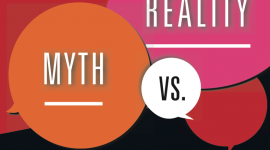Bipolar Facts and Statistics: Bipolar Disorder is Real

Facts about bipolar disorder are crucial if you want to understand the illness. Reading about people’s real-life experience with bipolar can be comforting and inspiring to those with the condition, but it’s important to remember that no two experiences are the same. There is a lot of misinformation about mental illness online, so how do you separate fact from fiction? Here are some facts about bipolar disorder that everyone should know.
Bipolar Disorder: Facts and Statistics Everyone Should Know
Bipolar disorder facts aren’t easy to come by. Whether it’s a misinformed comment from a friend or a thoughtless Tweet you read online, it’s easy to buy into people’s misconceptions about what bipolar disorder is actually like. Here are some bipolar disorder facts to provide a little perspective.
- According to The World Health Organization, bipolar disorder is one of the top three causes of hospitalization in people aged 15-44
- It is estimated that 5% of the world’s population is on the bipolar spectrum, while just 1-2% are diagnosed
- Bipolar disorder is more common than you might think. Around 4.4% of U.S. adults develop bipolar disorder at some time in their lives
- In adolescents, the prevalence of bipolar disorder is higher among females (3.3%) than in males (2.6%)
- Bipolar is a recurring illness. More than 90% of people who experience a single manic episode will go on to have another
- Around 60-70% of manic or hypomanic episodes occur before or after a major depressive episode
- Treatment is successful in the majority of cases. Approximately 20-30% of people living with bipolar type I disorder and 15% of those with bipolar II disorder experience significant symptoms despite treatment compliance.
- The average age of bipolar onset is 20 for both men and women, though the disorder can develop at any time.
Is Bipolar Disorder Real? Don’t We All Have Mood Swings?
Some people wonder whether bipolar disorder is even real. After all, don’t we all have good days and bad days? Aren’t mood swings normal? Here, we debunk some common myths with facts about bipolar disorder.
Myth: Bipolar disorder isn’t real
Fact: Everyone experiences highs and lows, but the mood "swings" in bipolar disorder are marked by specific symptoms, and the consequences can be severe. Bipolar disorder is not a figment of the imagination; it is a recognized, treatable brain disorder with strict diagnostic criteria ("How is Bipolar Disorder Diagnosed?"). It can also cause a lot of suffering if it is not well-managed. Someone with bipolar disorder cannot just snap out of it – they need proper treatment.
Myth: People with bipolar disorder don’t get better
Fact: Managing bipolar disorder is a lifelong challenge for most people, and there is currently no cure. However, many people can and do lead healthy, happy lives with bipolar disorder, and treatment for bipolar disorder can be highly effective. While medication is prescribed in the majority of cases, people with bipolar find that therapy and lifestyle changes can help their moods stabilize and fend off future episodes.
Myth: People with bipolar disorder are always ill
Fact: The mood changes in bipolar disorder don't always happen in regular cycles. For some people, symptoms of mania or hypomania or depression only show up once or twice a year. Symptoms can be triggered by stress or other external factors, such as divorce, bereavement, the loss of a job or abusing alcohol or drugs. However, none of these things can actually cause bipolar disorder.
Myth: Children can’t get bipolar disorder
Fact: Bipolar disorder can be diagnosed at any age. So, yes, bipolar disorder in children does exist. Children receive treatment in a similar way to adults with bipolar disorder, though it can be harder to diagnose because it displays similar characteristics to attention deficit disorders, such as ADHD.
It's essential to get bipolar disorder facts from trusted sources and not believe everything you read on the internet. If you are worried about bipolar disorder statistics or information you find online, it’s important to discuss your concerns with your doctor.
APA Reference
Smith, E.
(2021, December 28). Bipolar Facts and Statistics: Bipolar Disorder is Real, HealthyPlace. Retrieved
on 2026, January 16 from https://www.healthyplace.com/bipolar-disorder/bipolar-information/bipolar-facts-and-statistics-bipolar-disorder-is-real


